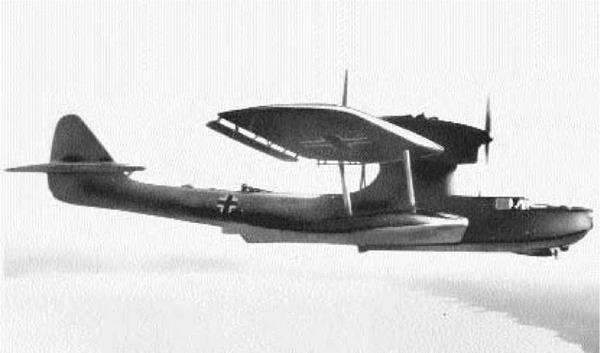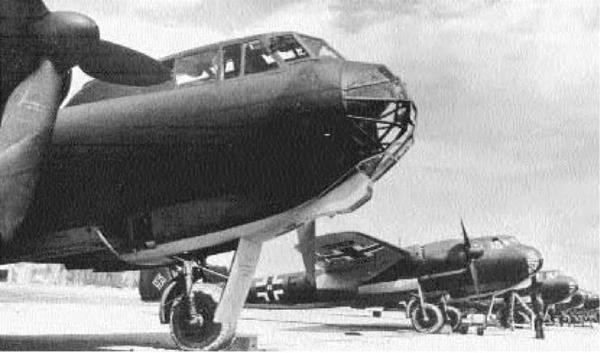. Dewoitine D 520
Dimensions: wingspan, 33 feet, 5 inches; length, 28 feet, 8 inches; height, 8 feet, 5 inches Weights: empty, 4,685 pounds; gross, 5,897 pounds
Power plant: 1 x 930-horsepower Hispano-Suiza 12Y45 liquid-cooled in-line engine Performance: maximum speed, 332 miles per hour; ceiling, 33,620 feet; range, 553 miles Armament: 4 x 7.5mm machine guns; 1 x 20mm cannon Service dates: 1939-1947
|
D |
ewoitine’s racy D 520 was the most modern and capable French fighter of World War II. It fought with distinction in 1940 and went on to serve Vichy forces in Syria and North Africa.
By 1937 the French government felt pressing needs for new and more modern fighter aircraft. That year the Morane-Saulnier MS 405 won the competition when Dewoitine’s entry, the D 513, proved inferior. The company subsequently went back to the drawing board under Emile Dewoitine, Robert Castello, and Jacques Henrat to redesign a totally new machine. The D 520 prototype first flew in October 1938 and was completely successful. It was an all-metal, low-wing monoplane fighter with stressed skin and retractable undercarriage. It was also heavily armed, possessing up to four machine guns and an engine-mounted 20mm cannon firing through the propeller hub. Moreover, the fighter plane proved impressively maneuverable and responsive, and it was faster than the MS 405. In 1939 the French government decided to purchase it in quantity.
The commencement of World War II in September 1939 did little to shake off the bureaucratic lethargy that plagued the French arms industry throughout the 1930s. Consequently, only one group de chasse (fighter group) was equipped with D 520s when the Germans invaded France in May 1940. Aircraft and pilots fought splendidly, claiming 147 enemy craft with a loss of 44 fighters, but France was nonetheless overwhelmed. Throughout the ensuing Vichy period, Germany allowed the D 520 to remain in production, and a total of 786 machines were built. They went on to reequip French forces in Syria and North Africa as Axis allies. In this capacity D 520s shot down numerous English airplanes while sustaining heavy losses of their own. In November 1942 Germany occupied Vichy France and impressed the surviving D 520s as trainers. After the Allied liberation of 1944, many Dewoitine fighters again passed into French hands and delivered parting shots against the retreating Germans. Several D 520s were subsequently converted into two-seat trainers and flown until 1947.
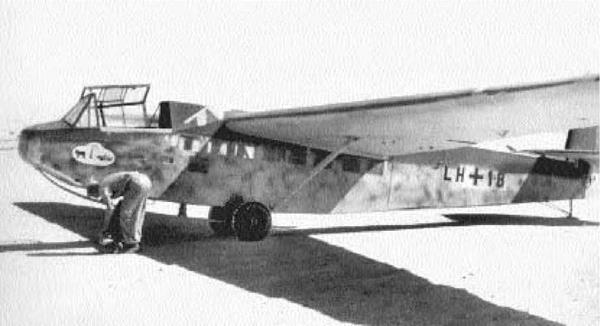
Type: Glider; Transport
Dimensions: wingspan, 68 feet, 5 inches; length, 36 feet, 10 inches; height, 9 feet Weights: empty, 1,896 pounds; gross, 4,630 pounds Power plant: none
Performance: maximum speed, 180 miles per hour Armament: 1 x 7.92mm machine gun Service dates: 1938-1945
|
T |
he DFS 230 undertook the world’s first, successful glider assault in 1940. Thereafter it was widely employed in less glamorous work of a supply transport.
In 1932 an experimental glider had been designed by the Rhon-Rossitten Gesellschaft agency for meteorological research. Soon it came to the attention of Luftwaffe leader Ernst Udet, who envisioned military potential for such craft. Accordingly, a prototype was constructed by the firm Deutsches Forschunginstitut fur Segelflug and tested in 1937 before a large gathering of senior officers. The DFS 230 was a high-wing design with a boxlike fuselage that took off under tow, jettisoned its wheeled undercarriage, and landed on a belly skid. It was flown by a crew of two and could hold up to eight soldiers. In the hands of noted aviatrix Hanna Re- itsch, the prototype landed within a few feet of the generals and quickly disgorged its passengers. Following this impressive display, the glider entered into production, and by 1938 Germany possessed the world’s first glider assault force.
In battle, the DFS 230s were usually towed by Junkers Ju 52 transports and released over a target, arriving silently and unannounced to the surprise of defenders. This is exactly what transpired on May 10, 1940, when 41 DFS 230s were assigned to take strategic Fort Eben-Emael on the Prince Albert Canal in Belgium. Nine gliders landed directly on target, stormed the fort, and held it against Belgian forces until the main German army arrived the following day. In May 1941 an even bigger force of 53 DFS 230s was towed in broad daylight over the British-held island of Crete. Resistance was fierce and losses heavy, but the island eventually succumbed to what was then the world’s largest airborne assault. Thereafter, most DFS 230s were employed in Russia, ferrying much-needed supplies to troops at the front. But perhaps their most notorious mission occurred on September 12, 1943, in Abruzzi, Italy. There a glider force under legendary commando Otto Skorzeny put down on mountainous terrain just outside the Rifugio Hotel and rescued Italian dictator Benito Mussolini. A total of 1,022 of these useful gliders were built.
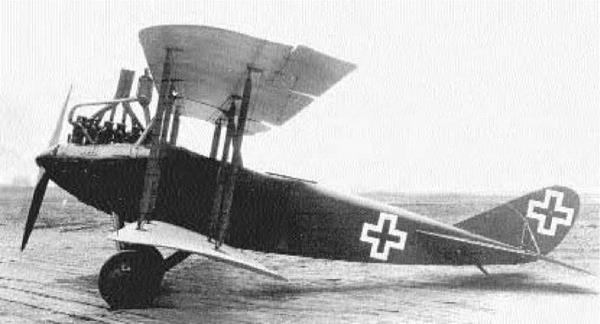
Type: Reconnaissance
Dimensions: wingspan, 43 feet, 7 inches; length, 25 feet, 10 inches; height, 19 feet, 8 inches
Weights: empty, 2,143 pounds; gross, 3,146 pounds
Power plant: 1 x 200-horsepower Benz Bz IV liquid-cooled in-line engine
Performance: maximum speed, 97 miles per hour; ceiling, 16,400 feet; range, 350 miles
Armament: 2 x 7.92mm machine guns
Service dates: 1916-1918
|
T |
he ubiquitous DFW C series was built in greater numbers than any other German aircraft of World War I. Amazingly acrobatic, it frequently out – maneuvered the latest Allied fighters.
Throughout 1914-1916 Deutsche Flugzeug – Werke manufactured an unarmed two-seat reconnaissance aircraft called the B I. Once outmoded by more advanced allied fighters, it spent the rest of the war in training capacities. Meanwhile, DFW moved ahead on newer two-seaters—the C series, which was both armed and more maneuverable than the earlier machines. The most important was the C IV, which appeared at the front in the spring of 1916. It was a conventional two-bay biplane constructed of wood and fabric. The 150-horsepower Benz III engine was semicowled in Germanic fashion to facilitate cooling, and it sported a typical “rhinoceros”-type exhaust pipe. In service the C IV demonstrated excellent qualities, but the introduction of better enemy fighters again prompted DFW to update the basic design.
A new machine—the C V—emerged in the summer of 1916. It was outwardly very similar to the C IV but possessed a more powerful Benz IV engine and other aeronautical refinements. Among them were rounded tail contours, balanced tail surfaces, and side radiators. This last item was subject to considerable revision once the machine was mass-produced, and later-model C Vs were fitted with a box – type leading-edge device. The C V was well adapted for photographic and artillery-spotting roles and retained all the maneuverability of earlier models. Moreover, it could easily outturn the latest French and British fighters in pursuit. DFW ultimately constructed 2,340 C types, making them the most numerous German aircraft of this conflict. C Vs constituted the largest variant produced and were manufactured by DFW, Aviatik, and Halberstadt. More than 600 C Vs remained in frontline service by war’s end. On June 17, 1919, a C V established a world altitude record of 31,561 feet.
|
Dimensions: wingspan, 77 feet, 9 inches; length, 63 feet, 2 inches; height, 17 feet, 6 inches Weights: empty, 12,897 pounds; gross, 22,046 pounds
Power plant: 2 x 880-horsepower Junkers Jumo 205D liquid-cooled in-line engines Performance: maximum speed, 162 miles per hour; ceiling, 13,780 feet; range, 2,175 miles Armament: 1 x 13mm machine gun; 1 x 20mm cannon; 220 pounds of bombs Service dates: 1939-1942
|
G |
raceful Do 18s formed the bulk of Luftwaffe maritime reconnaissance units in the early days of World War II. One of them suffered the indignity of becoming the first German aircraft lost to British forces.
Throughout the late 1920s, Deutsche Lufthansa transatlantic business was conducted on the Dornier Do 15 Wal (Whale) flying boat, which established several record flights. In 1934 its successor, the Do 18, first appeared. This craft incorporated many characteristics of the previous design, having retained the two large sponsons on either side of the midfuselage. These features endowed it with stability in the water and also provided additional lift while in flight. The Do 18 was powered by two engines in tandem arrangement, one pulling and one pushing, atop of the wing. Several were acquired by Lufthansa in 1936, and within two years one Do 18 established a world record by flying 5,214 miles nonstop from Germany to Brazil. The Luftwaffe, which had also employed the older Do 15, began utilizing
Do 18s as of 1939. These differed from civilian versions by having more powerful engines and gunner positions in the bow and midships.
Do 18s ultimately equipped five squadrons in the Kustenfliegergruppen (coastal reconnaissance groups) by the advent of World War II. They served primarily over the Baltic and North Sea, keeping a wary eye on British naval movements. On September 26, 1939, three Do 18s were shadowing the British fleet when they were suddenly attacked by Blackburn Skuas from the carrier HMS Ark Royal. One of the stately flying boats was shot down, becoming the first German plane lost in combat to Britain. After 1940 the Do 18s were slowly withdrawn from maritime reconnaissance in favor of air/sea rescue missions. These craft were subsequently painted all white with large red crosses and largely ignored until the British discovered them conducting electronic surveillance. By 1942 the handful of Do 18s still in service functioned as trainers.
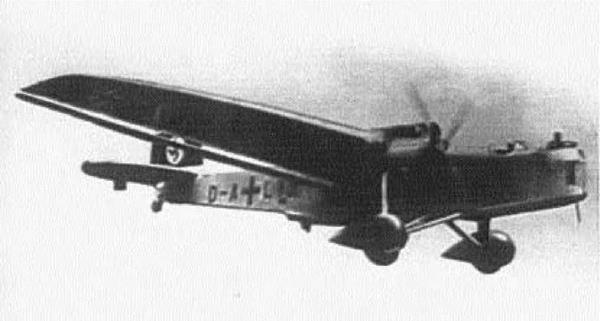
Type: Medium Bomber
Dimensions: wingspan, 84 feet; length, 61 feet, 8 inches; height, 18 feet
Weights: empty, 14,080 pounds; gross, 20,240 pounds
Power plant: 2 x 750-horsepower BMW VIU liquid-cooled in-line engines
Performance: maximum speed, 161 miles per hour; ceiling, 13,776 feet; range, 840 miles
Armament: 3 x 7.92mm machine guns; 2,205 pounds of bombs
Service dates: 1935-1940
|
T |
he Do 23, Germany’s first large bomber aircraft since World War I, was by most aviation standards an operational flop. However, it played a major role in helping reconstitute the Luftwaffe bomber force.
By 1930 Germany was increasingly disposed to ignore provisions of the 1918 Armistice, which forbade the nation from possessing combat aircraft. A number of firms, such as Dornier, had opened subsidiaries in Switzerland and other places to clandestinely develop such weapons. In this instance, Dornier had been entrusted to design Germany’s first large bomber since World War I. The prototype Do F was constructed at the company’s Swiss Al – tenhein factory in 1929, where it was marketed as a cargo transport intended for the German rail service. It was a twin-engine, high-wing monoplane design of metal construction. The fuselage was rectangular in cross-section, and the lengthy wings possessed a long chord. The big craft also possessed rudimentary retractable landing gear. The Do F was employed exactly as advertised, despite its uncanny
resemblance to a bomber. Moreover, its crews were actually military personnel being clandestinely trained in the rudiments of aerial warfare. From this was developed a more refined version, the Do 11, in 1933. With Adolf Hitler now in power, all pretense toward civilian applications was dropped.
The Do 11 bomber appeared very similar to the Do F, save for a glazed bombardier section in the nose. It entered production as the Luftwaffe’s first bomber but was unpopular due to bad landing characteristics; only 79 were produced. Another failed version, the Do 13, was also made in small numbers. When these were subsequently modified with revised wing and tail surfaces in 1936, the type was reintroduced as the Do 23. A total of 273 units were built, fleshing out the first Luftwaffe bomber groups. The airplane performed well as a trainer, but its shortcomings as a bomber meant early retirement from frontline service in 1937. A handful survived during World War II and were outfitted with degaussing equipment for oceanic minefield work.

Type: Reconnaissance
Dimensions: wingspan, 88 feet, 7 inches; length, 72 feet, 2 inches; height, 17 feet, 10 inches
Weights: empty, 29,700 pounds; gross, 40,565 pounds
Power plant: 3 x 1,000-horsepower Bramo Fafnir radial engines
Performance: maximum speed, 211 miles per hour; ceiling, 19,360 feet; range, 2,950 miles Armament: 2 x 7.92mm machine guns; 1 x 20mm cannon; 1,200 pounds of bombs Service dates: 1939-1945
|
T |
he Do 24 saw widespread service with the Luftwaffe as a reconnaissance and air/sea rescue craft. Throughout this same period it found similar employment with the Dutch and later Spanish navies.
In 1935 the Dutch government approached Dornier to build a new flying boat for use in the Royal Netherlands Naval Air Service. Because work on the Do 18 had just completed, the new airplane incorporated many features of its predecessor. The Do 24 was an all-metal, high-wing monoplane that utilized a typical two-step Dornier hull with large flotation sponsons on either side of the fuselage. The sizable tapered wing was fastened above the hull with struts and mounted three engines. A large twin rudder system was also employed. Service trials were excellent, and in 1939 the Do 24 entered Dutch service as part of the East Indies Air Forces. Several were also constructed in Holland under license.
In December 1941 the Japanese attack on the Dutch East Indies destroyed no less than nine
Do 24s. The remainder then fled to Australia, where another four succumbed to strafing. The surviving six Do 24s subsequently served with the Royal Australian Air Force in intelligence capacities until
1945. Following the German occupation of the Low Countries in 1940, all Do 24s then under production were seized and impressed by the Luftwaffe. These machines were outfitted as air/sea rescue craft and extensively flown in the Arctic, the Mediterranean, the North Sea, and the Atlantic. The Do 24 distinguished itself in this capacity, being stoutly built and able to operate in rough water conditions. In one instance a Do 24 lost its tail section in high seas, so the crew simply sealed off the leak and taxied several hundred miles to land! Production of this useful craft was maintained in France and Holland, with a total of 294 being built. As a goodwill gesture to Spain, several Do 24s were sold in 1944, and they operated as air/sea rescue craft up through the 1970s.
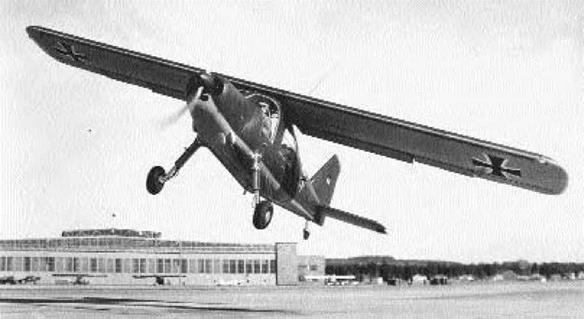
Type: Liaison; Trainer
Dimensions: wingspan, 39 feet, 4 inches; length, 31 feet, 4 inches; height, 8 feet, 10 inches
Weights: empty, 2,167 pounds; gross, 3,460 pounds
Power plant: 1 x 275-horsepower Lycoming GO-480 air-cooled engine
Performance: maximum speed, 155 miles per hour; ceiling, 10,825 feet; range, 685 miles
Armament: none
Service dates: 1957-
|
T |
he Do 27 was a successful postwar design and marked Germany’s reentry into military aviation. It was a functional, rugged aircraft with an exceptionally varied and lengthy service life.
In the aftermath of World War II, Germany was forbidden to possess or manufacture military aircraft of any kind. Consequently, Dr. Claude Dornier was forced to set up his office in Spain to continue working. In 1954 he received from the Spanish government specifications for a new light utility craft with STOL (short takeoff and landing) capabilities. That year the first prototype Do 25 flew as a high-wing, unbraced monoplane with fixed undercarriage and a spacious cabin. It was equipped with oversize flaps for good STOL performance. Another notable feature was the wide wraparound windscreen, which allowed for excellent vision. The machine displayed impressive qualities and was ordered in numbers by the government. In light of existing restrictions, however, they were constructed by CASA in Spain as Do 27s.
The changing political climate of Central Europe was then becoming transfixed over East-West confrontation as NATO under the United States faced off against the Warsaw Pact headed by the Soviet Union. The Americans were determined to make Germany a full-fledged military partner and allowed it to rearm. It was against this background that Dr. Dornier offered his new plane to the newly formed Luftwaffe (air force) and Heersflieger (army air force) of the Federal Republic of Germany. The Do 27, by virtue of its excellent ability to operate from short, unprepared strips became much in demand as an all-purpose liaison and general utility craft. Dornier then relocated back to Germany, where he constructed 428 of his rugged little airplanes. A second version, the Do 27B, was fitted with dual controls and operated as a trainer. Production concluded by 1966 after a run of 571 units. Given the great versatility of the Do 27, it was widely exported overseas to Israel, Nigeria, Belgium, Turkey, and Congo. Germany gradually replaced its Do 27s with helicopters in the late 1980s, and many were transferred to Portugal.
|
Dimensions: wingspan, 62 feet, 4 inches; length, 55 feet, 9 inches; height, 16 feet, 4 inches
Weights: empty, 19,985 pounds; gross, 36,817 pounds
Power plant: 2 x 1,700-horsepower BMW 810D radial engines
Performance: maximum speed, 348 miles per hour; ceiling, 24,170 feet; range, 1,550 miles Armament: 4 x 7.9mm machine guns; 2 x 13mm machine guns; up to 8,818 pounds of bombs Service dates: 1937-1945
|
T |
he “Flying Pencil” was a Luftwaffe workhorse throughout World War II. Although less numerous than competing Heinkel and Junker designs, it performed useful work in a wide variety of missions.
The Dornier Do 17 originated in a 1933 request by Deutsche Lufthansa for a modern highspeed carrier for mail and passengers. The prototype flew in 1934 as an all-metal, high-wing monoplane with a single fin. The new machine was fast, but the airline rejected it on account of its very narrow fuselage, which led to the name “Flying Pencil.” Then the Luftwaffe expressed interest in developing the craft as a bomber. Fitted with a twin rudder assembly, the new Do 17s made a splash at the 1937 Military Aircraft Competition at Zurich, where they proved faster than any fighter present. By 1938 several bombers had been committed to combat in Spain, where it was decided to provide the front cabin with the trademark “beetle – eye” canopy and heavier armament. More than
1,200 Do 17s were built, and in the early years of World War II they formed a vital part of the Luftwaffe bomber arm, along with He 111s and Ju 88s. Most were phased out by 1942.
In 1938 the Dornier design team conceived a progressive development, the Do 217. Despite outward similarities to the Do 17, this was an entirely new and more capable machine. Equipped with radial engines, it served throughout the war years as a day bomber, a night fighter, and a dive-bomber. Like its predecessor, the Do 217 was fast, easy to fly, and very adaptable. By 1944 Model M and Model K versions were equipped to handle Fritz X guided antiship missiles during the Italian campaign. In this capacity Do 217s sank the British cruiser HMS Janus and also the Italian battleship Roma as it fled to join the Allies. Others were successfully rigged as night fighters. A final reconnaissance version, the Do 217P, could reach altitudes of 50,000 feet. More than 1,700 Do 217s were built.
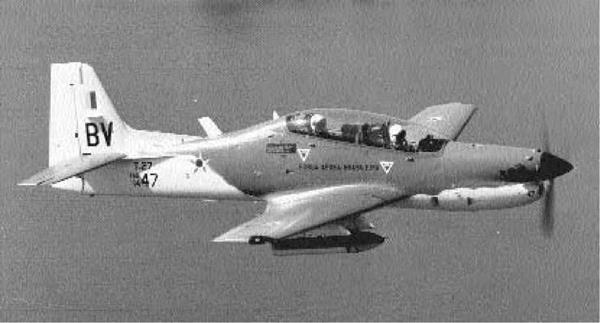
Type: Trainer
Dimensions: wingspan, 36 feet, 7 inches; length, 32 feet, 4 inches; height, 11 feet, 2 inches Weights: empty, 3,990 pounds; gross, 7,000 pounds
Power plant: 1 x 750-horsepower Pratt & Whitney Canada PT6A-25C turboprop engine Performance: maximum speed, 278 miles per hour; ceiling, 30,000 feet; range, 1,145 miles Armament: none Service dates: 1983-
|
T |
he racy Tucano is South America’s first and most successful advanced training aircraft. It continues to be widely exported abroad in a number of versions.
In 1978 the Brazilian government approached Embraer to design a new trainer to replace its aging fleet of Cessna T-37s. The new craft would not only have to be cost-effective but also closely mimic jet flight characteristics. That year a design team under Joseph Kovacs began work on a prototype that was unveiled in August 1980. The EMB 312 Tucano (Toucan) is a low-wing, turboprop monoplane with exceedingly sleek lines. It seats two crew members in tandem under a spacious staggered canopy and is the only aircraft of its class fitted with ejection seats. The Tucano derives its name from a long and distinct cowling, which houses a powerful Pratt & Whitney Canada turboprop engine. To better mimic the handling characteristics of jet flight, it also features a throttle control that simultaneously synchronizes the propeller pitch. This assures smooth and rapid ac
celeration and deceleration. The plane exhibited delightful flying characteristics, so in 1983 the first EMB 312 was delivered to the Air Force Academy near Sao Paulo. Such high performance and low operating costs also attracted outside attention, with Egypt purchasing no less than 54 of these fine machines. In short order, Argentina, Columbia, Honduras, Paraguay, and Venezuela all purchased Tucanos for their cadets. The latest customer is France, which in 1994 ordered 80 examples with air brakes and deicing equipment.
By far the most significant user of the EMB 312 is Great Britain, which in 1985 sought to replace its BAe Jet Prevost trainers. Choosing the Tucano was significant because it represents the first trainer since the de Havilland Chipmunk of 1950 to seat pilots in tandem, not side by side. The British Tucanos are manufactured in Belfast by Shorts and are fitted with a more powerful Garrett turboprop engine and other advanced avionics. Thus far, more than 600 Tucanos have been built and exported around the world. A Brazilian success story!
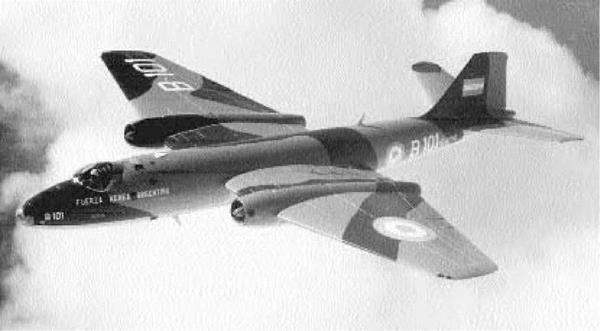
Type: Light Bomber; Reconnaissance
Dimensions: wingspan, 63 feet, 11 inches; length, 65 feet, 6 inches; height, 15 feet, 8 inches
Weights: empty, 27,950 pounds; gross, 54,950 pounds
Power plant: 2 x 7,400-pound thrust Rolls-Royce Avon turbo jet engines
Performance: maximum speed, 541 miles per hour; ceiling, 48,000 feet; range, 806 miles
Armament: 4 x 20mm cannons; up to 5,000 pounds of bombs
Service dates: 1951-
|
T |
he legendary Canberra was originally designed as a light bomber, but it also gained renown as a high-altitude spyplane. This superb machine was one of the most versatile aircraft ever constructed, and a handful still operate today—half a century after initial deployment.
The high performance of German jets in World War II prompted the British Air Ministry to release Specification B.3/45 in 1945 to acquire Britain’s first jet bomber. At length designer W. E.W. “Teddy” Pet – ter of English Electric decided against the very latest swept-wing philosophies then in vogue in favor of a conventional straight-wing design. He selected a very low-aspect wing, which was thin, broad, and ensured good fuel economy at very high cruising altitudes. The first Canberra debuted in 1949 to the astonishment and delight of the Royal Air Force. It was a streamlined machine with two engines mounted midway in-between the wings. The fuselage was smooth and monocoque in construction,
seating two pilots under a large bubble canopy near the nose. From the onset, the new craft was amazingly fast and agile at low altitude. In 1951 the first Canberra B.2s were deployed, the first of 27 distinct marks that were produced over a decade. Canber- ras were also highly successful as an export machine, and they served in great numbers with Argentina, South Africa, Australia, Germany, Kuwait, India, Sweden, the United States, and France. A total of 1,352 of these classic jet bombers were built.
It is not always appreciated that RAF Canber- ras conducted some of the earliest high-altitude overflights of the Soviet Union in the early to mid-1950s. In concert with Martin RB-57s—the U. S. version— these were some of the earliest spy flights of the Cold War. The advent of Soviet surface-to-air missiles curtailed these activities by 1960, and RAF machines reverted back to bombers and tactical reconnaissance until the 1980s. However, India still maintains and operates a large refurbished fleet of 65 Canberras.
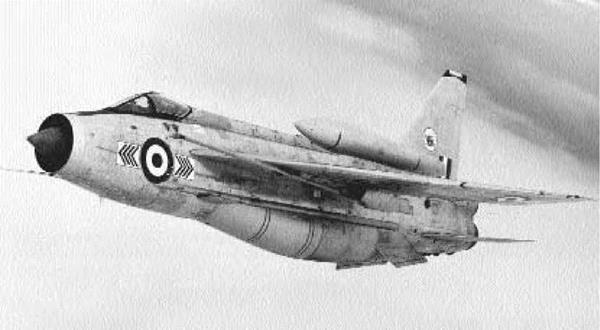
Type: Fighter
Dimensions: wingspan, 34 feet, 10 inches; length, 55 feet, 3 inches; height, 19 feet, 7 inches Weights: empty, 28,000 pounds; gross, 50,000 pounds
Power plant: 2 x 15,680-pound thrust Rolls-Royce Avon 302 turbojet engines Performance: maximum speed, 1,500 miles per hour; ceiling, 40,000 feet; range, 800 miles Armament: 2 x 30mm cannons; 2 x Red Top or Firestreak missiles Service dates: 1961-1988
|
T |
he fabulous Lightning was England’s first supersonic fighter, as well as the first designed as an integrated weapons system. Despite maintenance headaches, it gave the Royal Air Force world-class interception capability.
The Air Ministry announced Specification
F. 23/49 in 1949 to stimulate production of a fighter that could operate faster than the speed of sound in level flight. W. E.W. “Teddy” Petter of English Electric had already designed a research craft called the P.1A, which was being constructed for that purpose. The prototype first flew in August 1954 with good results, but further development yielded the P.1B, a dramatically different aircraft. The most unusual feature was the engine arrangement—one stacked atop the other—which eliminated the need for a greater frontal area. The wings were also unusual in that they, as well as the tail surfaces, terminated at right angles to the flow of air. The P.1B became the first British aircraft to fly at twice the speed of sound in March 1958, and the government decided to enter it
into production as the Lightning. The first machines became operational in 1961 and differed from the prototype in having a faired bulge on the bottom of the fuselage for housing additional fuel. In service the Lightning was fast, highly agile, and possessed twice the performance of the aging Hawker Hunters. In time it developed into a world-class interceptor. However, with high speed came high fuel consumption, and the first F.1s were somewhat short-ranged. They were also dogged by recurrent maintenance problems, as technology this complex was a novelty.
The Lightning was also the first British fighter to serve as an integrated weapons system and not simply as a gunnery platform. It was equipped with an advanced fire control radar that simultaneously tracked targets and fired weapons at optimum range. A total of 338 of these impressive machines were built, and they remained in service until replaced by Panavia Tornados in 1988. Several were also exported to Saudi Arabia and Kuwait. This was a superb interceptor in its day.











